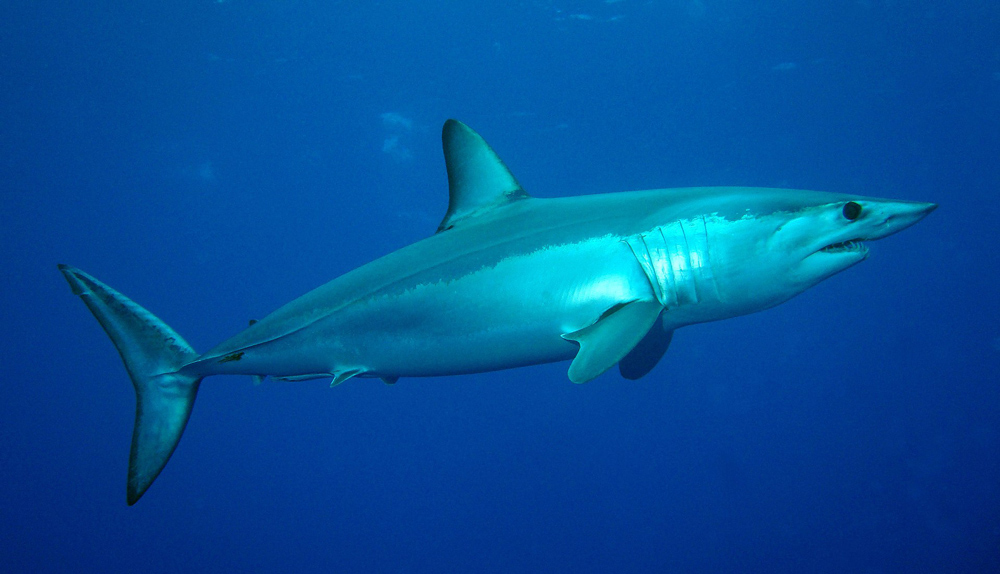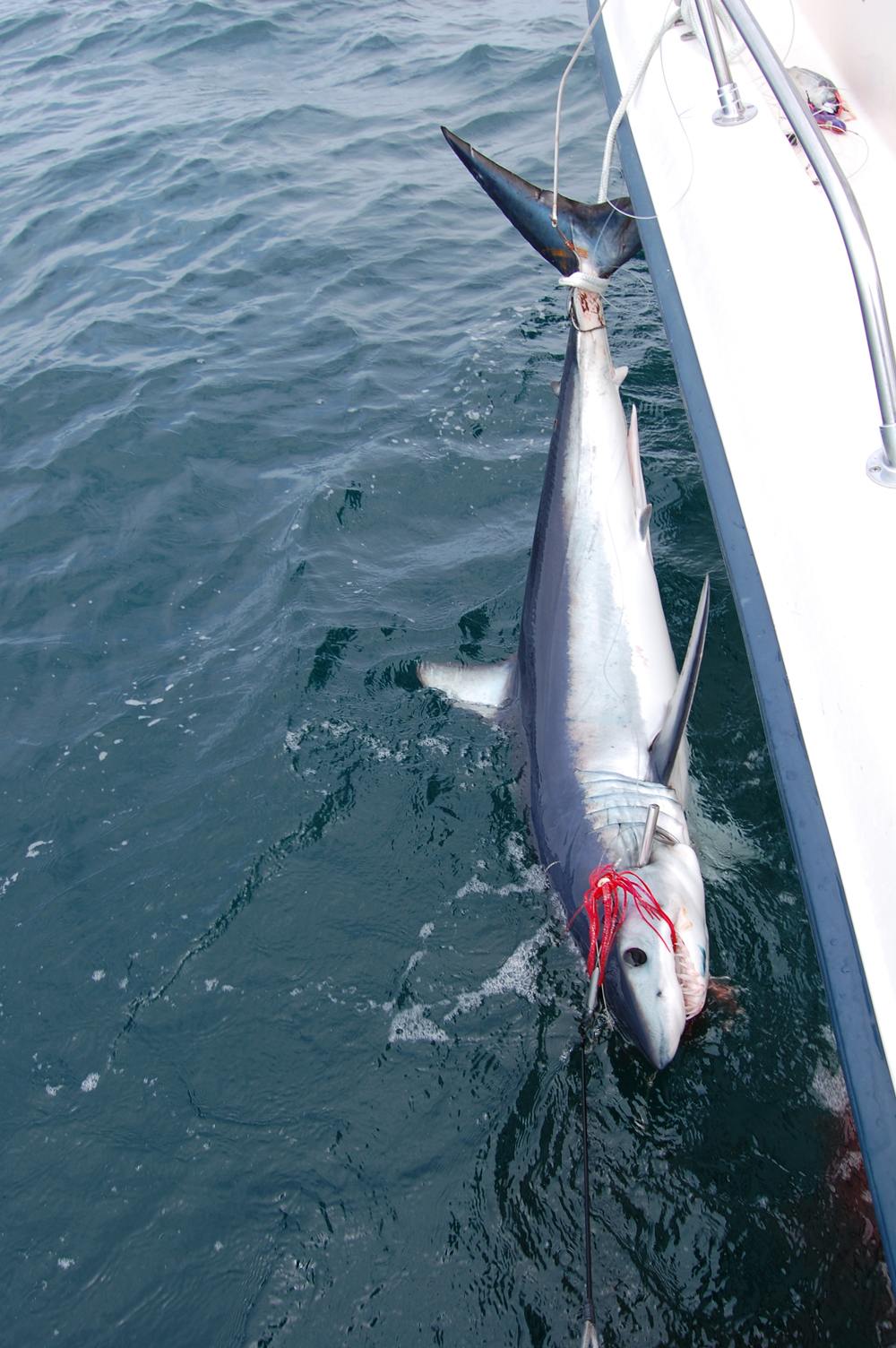One of the first available pelagics of the year should soon be chomping bluefish into pieces in as close as the 20 Fathom Fingers. Out in the canyons when the year's first schools of yellowfin are found in eddies spinning off the gulf stream, the same predators – mako shark – will be found there feasting, as well. But catching these fish is no easy chore, and a successful day of sharking combines luck and know-how. We leave it to you to scrounge around and find some luck, but in the meantime here's some advice from shark experts to help you hang that scale-buster.

Captain Bryce Poyer (Blushing Rose) has hung many tackle-busting Mako on the scales for his charter clients. He says early in the season, place bait above thermocline where water is warmest. Typically a four rod spread is used, with three lines drifting and one line off a kite. Bryce says, “A live Bluefish in the one- to two-pound range is hard for a mako to pass up when fished off a kite.” Bluefish fillets and large squid fill out the spread to entice bites. When deciding on a location to drop the lines, in addition to water temperature Bryce says to try and locate schools of baitfish; find them and Mako will probably be in the area feeding.
Captain John Raguso (MarceeJay) has logged over 800 mako catches. He says his strategy changes over the shark season. Early on, larger mako will be found in the deep with water temps between 58 and 62 degrees. As inshore waters reach 62 to 64 degrees, mako will move in and chase bluefish. John’s favorite bait is whatever the mako are feeding on, but says an angler cannot go wrong with a one pound bluefish on the hook. He stresses the importance of moving bait and advises that when there is no current or wind, you keep the boat moving by bumping an engine in and out of gear. He offers this tip for success: “Anglers need to dress baits in lime green or yellow skirts.”
Captain Brian Perry (Sweetie) chases Mako up and down the east coast in tournaments and consistently finds a way to keep Sweetie on leader boards. When it comes to favorite bait Brian says you should, “match the hatch, and give them what they are feeding on which is normally bluefish early in the season.” Brian tends to fish from the 30-fathom line out to the edge and says monsters typically prefer deep water. Brian fishes four lines set at 50, 75, 100 feet and one bait just off bottom. A fifth line suspends a bluefish filet off an outrigger creating an enticing fluttering motion as the boat rocks back and forth. When it comes to chum, bunker, mackerel, or bluefish is used along with buckets of Gulp chum to create a slick.
Captain Jack Sprengel and Captain Lou Defusco (Hot Reels) have won the Snug Harbor shark tournament five times. When targeting mako they set up wherever clear green or ideally clear blue 66 to 68 degree water can be found. A three-rod set up is used, with the furthest bait from boat set at a depth near the thermocline and the other two lines staggered in depth back towards the boat. A fourth rod is rigged and ready to go for sight casting to any mako that follows the chum slick to the boat. First choice for chum is fresh ground bluefish. Bait preference is fresh bluefish or bluefin bellies. Once a mako is fought close to boat, Jack suggests placing the engines in gear and says, “You never know what a mako will do at boat-side, it can be a chaotic encounter, so be prepared!” He reiterates to use extreme caution when the leader is in hand and during the gaffing process.
Captain Bill Brown (Billfish) has led clients to several IGFA records. When it comes to mako, Bill says to think about the shark’s senses. Their incredible sense of smell should dictate the plan of action; fresh oily menhaden is first choice for chum. One or two five-gallon buckets is plenty for a day offshore; there’s no need to over-chum. Consider temperature and structure when identifying where to fish and be sure the chum slick passes over structure. When it comes to bait, Bill says, “It’s hard to beat a live bluefish, mackerel or menhaden on the hook.” He deploys a four-rod spread with live bait above the thermocline, staggered at various depths. Slow day of action? When this occurs Bill uses the engines to emit sound and vibration to draw sharks.

Personally, I prefer a live bluefish suspended under kite, swimming in circles near the surface. Keep in mind, depending on size of mako, it will take at least two to three bites to get a four- or five-pound bluefish down. Meaning, when you see the mako splashing around attacking the bluefish don’t be in a hurry to set the hook. In addition to the kite rod, three rods are staggered at various depths from the surface down to the thermocline in the chum slick. The surface bait is suspended five feet under a float and positioned furthest from boat, at about 100 yards. This rod receives a lot of attention from mako travelling up top, following the slick. One additional rod places a bait just off bottom, directly under boat. This set-up has accounted for several tournament checks for our charters.
Everyone basically rigs the same, using “J” or circle hooks. Typically, it includes a 10-foot piece of 250 to 400 pound-test mono crimped to a barrel swivel. The swivel has a four- to five-foot piece of single strand #12 wire (180 pound) or #15 (278 pound) to which a 9/0 to 12/0 2X hook is attached. No multiple strand wire should be used; it can be chewed through by a mako’s powerful jaws and sharp teeth, strand by strand. If using a circle hook it’s imperative not to fully embed the hook in the bait, which prevents a clean hook-set.
Editor's Note: Shark fishing regulations are constantly changing; get the latest regs by visiting the NOAA Atlantic Sharks webpage.
-By John Unkart
For additional info on shark fishing check out the author’s books, “Offshore Pursuit” and “Saltwater Tales.”